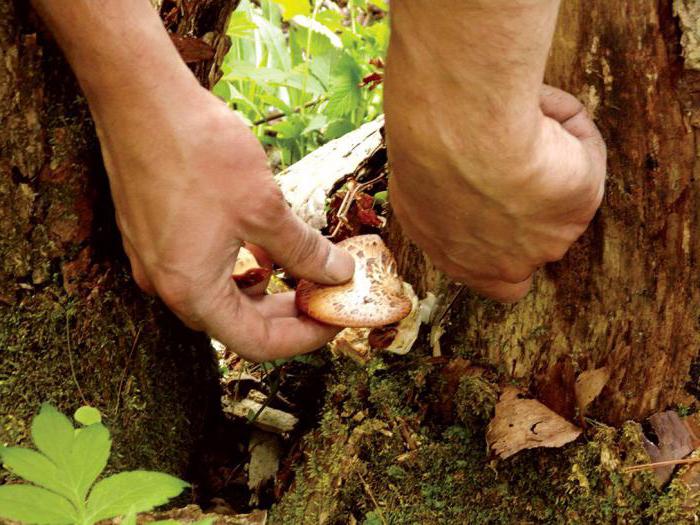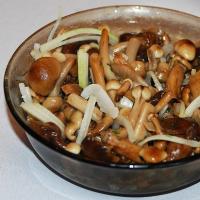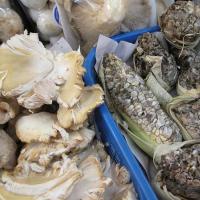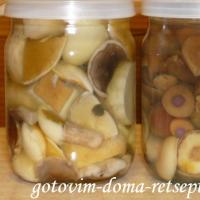Spring mushrooms: names, description, where they grow and when to collect
Most urban residents who see mushrooms mainly on supermarket shelves are sure that they grow in summer and autumn. Yes, mass collection takes place at this time, but the first mushrooms appear in the spring. That's what we'll talk about in this article.
Every year, avid mushroom pickers look forward to when the snow melts in the forest and the first green grass appears. In April and May, lovers of mushrooms with excellent taste go on a “quiet hunt”. These are magnificent spring morel mushrooms, and lines that are in no way inferior to morels in taste, but at the same time dangerous without special treatment. And these are not all the mushrooms that are the first to delight people with their appearance. Below we list the spring mushrooms that are suitable for eating.
Mushroom morel: description
Many have seen photographs and drawings of these edible spring mushrooms, but not everyone can see the mushroom with their own eyes. Get out for a few hours on a free May day in nature, and, quite possibly, luck will smile at you.
The description of the fungus in various sources suggests that it prefers light, well-warmed places by the sun, forest edges. Sometimes it can be found along the paths. Most often mushrooms come across under aspens, an alder and poplars. Collection time - April-May. As experienced mushroom pickers say, you need to have a “flair” for morels, which, as they assure, comes with time. Morels can be seen even within the boundaries of a large city - among willow thickets, on the ground covered with brick chips, mushrooms stick out in rows, resembling miniature space rockets.  The stem of this mushroom is about a centimeter in diameter, with a light cream hollow cap. Its upper part is completely different from the caps of other mushrooms: it is conical or cylindrical, with a characteristic cellular structure. Morel spores appear on such a surface. These mushrooms in the Moscow region are quite large in size, but they weigh a little, because they are hollow inside.
The stem of this mushroom is about a centimeter in diameter, with a light cream hollow cap. Its upper part is completely different from the caps of other mushrooms: it is conical or cylindrical, with a characteristic cellular structure. Morel spores appear on such a surface. These mushrooms in the Moscow region are quite large in size, but they weigh a little, because they are hollow inside.
Morels are edible mushrooms, even considered a delicacy in many countries. But when preparing them, do not forget to pre-boil for thirty to forty minutes, and pour the broth. 
Stitches
Another of the first spring mushrooms, the characteristics of which are rather contradictory. In our country, there are two types of lines: giant and ordinary. Lines in the forests are much more common than morels. They are probably less demanding on external conditions and more tenacious. They grow in clearings, conflagrations, in open places in deciduous and pine forests. You can find them from the earliest spring, as soon as the snow melts, until May. Sometimes lines appear even in the winter thaw.
Like morels, these mushrooms grow under deciduous trees and near rotting trunks, stumps, and branches. They differ in voluminous hats that have an irregular shape with deep convolutions. The legs are painted light grey. The cap is usually buffy, but can also be light brown or yellow-brown.
And finally, the main question: are the lines edible? In our country, experts classify them as conditionally edible. In other words, you can eat mushrooms, but after a long soak in cold water and boil. Western experts believe that the lines are poisonous, since cases of severe poisoning by these mushrooms have been recorded, even with a fatal outcome. In fact, this happened because the lines were not boiled before the main preparation. 
Spring meadow mushrooms - mushrooms
They appear on forest edges and meadows in mid-May. These are meadow mushrooms - thin lamellar mushrooms that grow in large colonies, as if compensating the mushroom pickers for their small size. And they are really small: a hat with a diameter of no more than four centimeters. The thickness of the cap is about five millimeters. The leg is quite long - it can grow up to ten centimeters, but its diameter is slightly thicker than a match.
The cap and stem are the same color, light chestnut or yellowish-brown. The plates are ocher-cream or cream, rather wide. The pulp is whitish with a pleasant mushroom aroma, but almost tasteless. These mushrooms are usually boiled, fried, but more often dried. They make delicious soups and sauces.
These spring edible mushrooms have a poisonous twin - conical hygrocybe. Unlike the "original", this mushroom has no smell, and its hat is conical in shape, reminiscent of a Vietnamese headdress. In the meadow honey agaric, the hat is never pointed. 
Raincoats
These are spring mushrooms of the Moscow region, which appear after May, already warm rains in birch and pine forests. At this time, you can see the round white heads of raincoats. These mushrooms as such do not have stems and caps. Their body is homogeneous and has the shape of a pear or a ball. They are painted in snow-white or grayish-white color.
There are three types of raincoats:
- prickly raincoat;
- golovach;
- giant fluke.
The prickly raincoat and the golovach have the shape of a light bulb, the giant fluff is a ball. The golovach and the giant porkhovik have a smooth white skin, which is easily separated from the fungus when pressed with a hand. Prickly raincoat - a small mushroom, no more than ten centimeters high, with a scaly surface. Spring raincoat mushrooms can be eaten only when they are very young, and their flesh is snow-white and elastic.
In aging mushrooms, the flesh acquires a yellowish tint. This mushroom is no longer edible. Raincoats are very tasty when fried. The skin needs to be cleaned first. You don't need to boil them. Unlike other mushrooms, puffball does not secrete mucus when fried and, when fried, looks like french fries with the taste of young tender meat.
And these mushrooms have a double - a poisonous false raincoat. It has a grayish-yellowish shell, and the flesh is dark purple with an unpleasant swing. 
Champignon
These spring edible mushrooms are probably known to everyone, since they are most often seen on sale in supermarkets. Champignon grows in large colonies in fields and meadows, pastures for livestock and vegetable gardens. These mushrooms are found even in urban forest park areas.
The genus of champignons consists of eight species, which differ in their place of growth and small external signs. All species are united by a common structure.
Description of champignon
The hat is white or slightly brownish in color, smooth or finely scaly, convex. In a young mushroom, it has a rounded shape. Connected to the leg, which is covered with a milky film. Over time, the mushroom cap increases in diameter, acquires a less pronounced spherical shape, and in old mushrooms it becomes almost flat. At the same time, the film is torn on the leg and a ring is formed.
The flesh is white, quickly turns pink when cut, with a strong and pleasant smell. Champignons are fairly large mushrooms. In the meadows there are myceliums up to fifty meters in diameter. They come across specimens with hats up to thirty centimeters in diameter. 
To many of our readers, this mushroom is known as a cultivated species, which is quite simply grown in gardens and vegetable gardens, in cellars. In France, mushrooms were grown in quarries as early as the 17th century. Later they were bred in the USA, England, Hungary, Czechoslovakia and other countries. In our country, champignons began to be bred at the beginning of the 19th century.
Today, in special greenhouse plants in the Moscow region, Rostov-on-Don, St. Petersburg, Simferopol and other cities, a huge amount of tasty and fragrant mushrooms are harvested throughout the year.
Mushroom pickers need to know that there is also a poisonous type of champignon, which is distinguished by the fact that its flesh at the break acquires a rich yellow color and has the smell of carbolic acid.
Aspen mushrooms
Judging by the name, it is not difficult to understand that most often these spring mushrooms grow under aspens. Often this species can be found in aspen-birch groves, and in mixed forests. Nevertheless, the mycelium is associated precisely with aspen. In the shade of the crown of these trees on moist soils, the boletus fungus is found singly or in small families. 
There are many varieties of boletus. Almost all of them are edible, but there are also false aspen mushrooms.
dung beetles
These spring mushrooms appear at the same time as champignons. They have small egg-shaped caps. They grow on well-fertilized soil, in vegetable gardens and gardens, around trees, even on sidewalks, where there is still at least a small piece of land left. They grow only in families, clinging very tightly to each other with hats.
When young, these mushrooms are edible. Depending on the species, they are painted in light gray, orange or white. The color of the hats of dung beetles varies by species - gray, white and shimmering.
Oilers
These spring mushrooms are harvested in coniferous forests. They are loved by many experienced mushroom pickers. Mushrooms got their name because of the oily hat that is slippery to the touch. Butter mushrooms can be consumed boiled, fried, salted, pickled. For drying, they are used extremely rarely, although they are also suitable.
Butter mushrooms are relatively early mushrooms. In the Moscow region, they are harvested in cleared pine forests in the first days of June. This period lasts no more than two or three weeks. Then butterflies disappear and reappear already in the second half of July, and the mass collection of these mushrooms occurs from the second half of August to the first decade of September.



